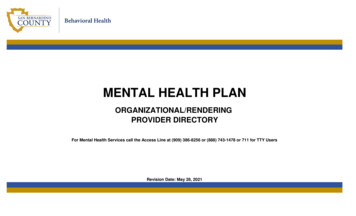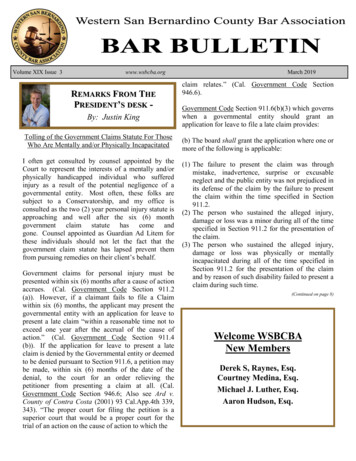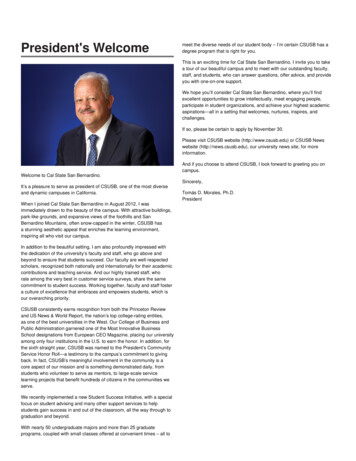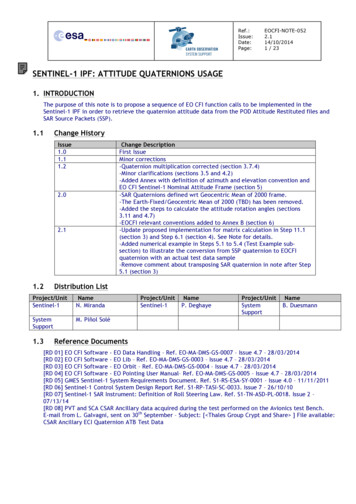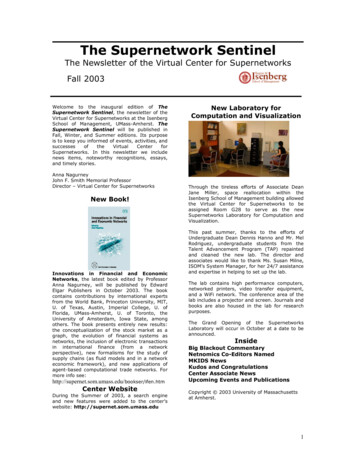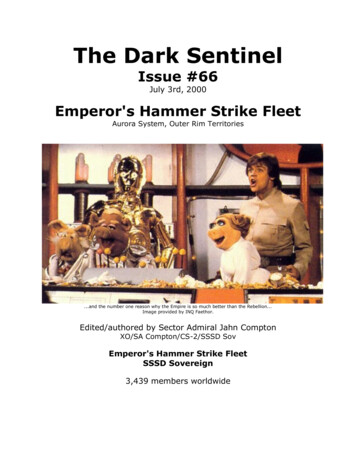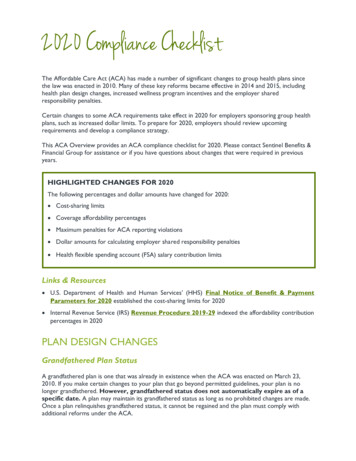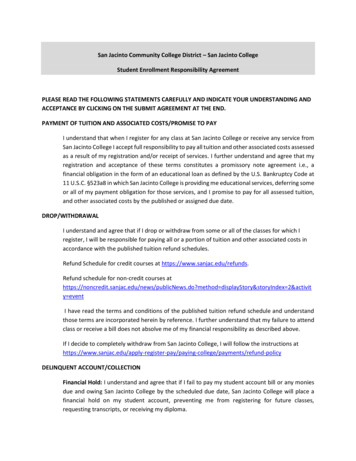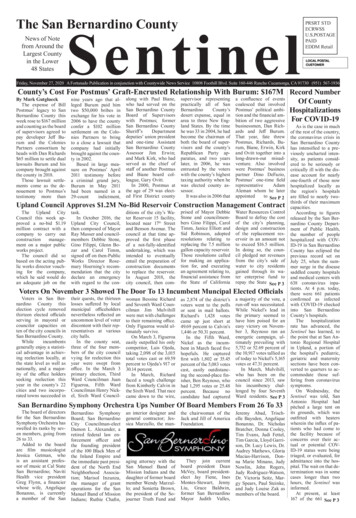
Transcription
SentinelThe San Bernardino CountyNews of Notefrom Around theLargest Countyin the Lower48 StatesPRSRT STDECRWSSU.S.POSTAGEPAIDEDDM RetailFriday, November 27, 2020 A Fortunado Publication in conjunction with Countywide News Service 10808 Foothill Blvd. Suite 160-446 Rancho Cucamonga, CA 91730 (951) 567-1936County’s Cost For Postmus’ Graft-Encrusted Relationship With Burum: 167M Record NumberBy Mark Gutgluecknine years ago that al- along with Paul Biane, supervisor representing a confluence of eventsOf CountyThe expense of Bill leged Burum paid him who had served on the practically all of San coalesced that involvedCounty’s Postmus’ political ambi- HospitalizationsPostmus’ legacy to San two 50,000 bribes in San Bernardino County BernardinoBoardofSupervisorsdesertexpanse,equal in tion and the financial amBernardino County this exchange for his vote inwithPostmus;formerareatothreeNewEng- bition of two aggressive For COVID-19week rose to 167 million 2006 to have the countyand counting as the boardof supervisors agreed topay developer Jeff Burum and the ColoniesPartners consortium heheads with Dan Richards 65 million to settle duallawsuits Burum and hiscompany brought againstthe county in 2018.Those lawsuit settlements come as the denouement to Postmus’stestimony more thanconfer a 102 millionsettlement on the Colonies Partners to bringto a close a lawsuit thatcompany had initiallybrought against the county in 2002.Based in large measure on Postmus’ April2011 testimony beforea criminal grand jury,Burum in May 2011had been named in a29-countindictment,San Bernardino CountySheriff’sDepartmentdeputies’ union presidentand one-time AssistantSan Bernardino CountyAssessor Jim Erwin;and Mark Kirk, who hadserved as the chief ofstaff of another Postmusand Biane board colleague, Gary Ovitt.In 2000, Postmus atthe age of 29 was elected First District countytask.In October 2016, theUpland City Council,then composed of MayorRay Musser and councilmembers Debbie Stone,Gino Filippi, Glenn Bozar and Carol Timm,signed off on then-PublicWorks Director Rosemary Hoerning’s recommendation that the citydeclare an emergencywith regard to the con-ditions of the city’s Water Reservoir 15 facility,located near 17th Streetand Benson Avenue. Thecouncil at that time approved the first phaseof a not-fully-identifiedundertaking, which wasintended to eventuallyentail the preparation ofconstruction documentsto replace the reservoir.In August 2018, thecity council, then com-land States. By the timehe was 33 in 2004, he hadbecome the chairman ofboth the board of supervisors and the county’sRepublican Party apparatus, and two yearslater, in 2006, he wasentrusted by the voterswith the county’s highesttaxing authority when hewas elected county assessor.It was also in 2006 thatbusinessmen, Dan Richards and Jeff Burum.That year, fate threwPostmus, Richards, Burum, Biane, Erwin, Kirkand Ovitt together into along-drawn-out misadventure. Also involvedwere Postmus’ businesspartner Dino DeFazio,Postmus’ one-time fieldrepresentativeAdamAleman whom he laterappointedto See P 2Upland Council Approves 1.2M No-Bid Reservoir Construction Management ContractThe Upland CityCouncil this week approved a no-bid 1.19million contract with acompany to carry outconstructionmanagement on a major publicworks project.The council did sobased on the acting public works director vouching for the company,which he said would doan adequate job on theprised of Mayor DebbieStone and councilmembers Gino Filippi, CarolTimm, Janice Elliott andSid Robinson, adoptedresolutions relating toreplacing the 7.5 milliongallon capacity reservoir.Those resolutions calledfor making an application for, and executingan agreement relating to,financial assistance fromthe State of CaliforniaWater Resources ControlBoard to defray the costof the city’s planning,design and constructionof the replacement reservoir in an amount notto exceed 16.5 million.In doing so, the council pledged net revenuesfrom the city’s sale ofwater to city residentsgained through its water enterprise fund torepay the State See P 3Voters On November 3 Showed The Door To 13 Incumbent Muncipal Elected OfficialsVoters in San Bernardino County thiselection cycle removedthirteen elected officialsserving in mayoral orcouncilor capacities onten of the city councils inSan Bernardino County.Whileincumbentsgenerally enjoy a statistical advantage in achieving reelection locally, atthe state level as well asnationally, and a majority of the office holdersseeking reelection thisyear in the county’s 22cities and two incorporated towns succeeded intheir quests, the thirteenlosses suffered by localmunicipal officeholdersnevertheless reflected anuncommon level of voterdiscontent with their representatives at variouscity halls.In the county seat,three of the four members of the city councilvying for reelection thisyear were swept fromoffice. In the March 3primary election, ThirdWard Councilman JuanFigueroa, Fifth WardCouncilman Henry Nickel, Sixth Ward Council-woman Bessine Richardand Seventh Ward Councilman Jim Mulvihillwere met with challengesto their remaining office.Only Figueroa would ultimately survive.On March 3, Figueroaeasily outpolled his onlycompetitor, Luis Ojeda,taking 2,098 of the 3,015total votes cast or 69.59percent to Ojeda’s 917 or30.14 percent.In March, Richardfaced a tough challengefrom Kimberly Calvin inthe Sixth Ward. That racecame down to the wire,as 2,874 of the district’svoters went to the pollsor sent in mail ballots.Richard’s 1,428 votescame up just short at49.69 percent to Calvin’s1,446 or 50.31 percent.In the Fifth Ward,Nickel as the incumbent in March faced fivehopefuls. He capturedfirst with 1,802 or 35.45percent of the 5,083 votescast, easily outdistancing the second-place finisher, Ben Reynoso, whohad 1,295 votes or 25.48percent. Because nocandidate had captureda majority of the vote, arun-off was necessitated.While Nickel’s lead inthe primary seemed tohave him poised for aneasy victory on November 3, Reynoso ran anenergetic campaign, ultimately prevailing with5,752 or 52.69 percent ofthe 10,917 votes tallied asof today to Nickel’s 5,165votes or 47.31 percent.In March, Mulvihill,who has been on thecouncil since 2013, sawhis incumbency challenged by four SeventhWard residents. See P 3San Bernardino Symphony Orchestra Ups Number Of Board Members From 26 To 33The board of directorsfor the San BernardinoSymphony Orchestra hasswelled its ranks by seven members, going from26 to 33.Added to the boardare film musicologistJessica Getman, whois an assistant professor of music at Cal StateSan Bernardino; NavitiHealth vice presidentGreg Flynn, a financierwhose wife, AngeliqueBonanno, is currentlya member of the SanBernardino SymphonyBoard; San BernardinoCity Councilman-electDamon L. Alexander, aretired federal law enforcement officer andthe founding presidentof the 100 Black Men ofthe Inland Empire andthe immediate past president of the North EndNeighborhood Association; Marisol Inzunza,the manager of grantoperations for the SanManuel Band of MissionIndians; Ruthie Chafin,an interior designer andgeneral contractor; Jessica Marzullo, the man-the chairwoman of theJack and Jill of AmericaFoundation.aging attorney with theSan Manuel Band ofMission Indians and thedaughter of former boardmember Wendy Marzullo; and Sonietta Brown,the president of the Sojourner Truth Fund andThey join currentboard president DeanMcVey, board presidentelect Jay Fiene, InesMontes-Stewart, JennyLiu, Grace Baldwin,former San BernardinoMayor Judith Valles,Jeremy Abad, Trischelle Baysden, AngeliqueBonanno, Dr. NicholasBratcher, Donna Cooley,Tim Evans, Judi Fettel,Tim Garcia, Lloyd Garrison, Dr. Lucy Lewis, Dr.Audrey Mathews, GloriaMacias-Harrison, Donna Marie Minano, JudyNowlin, John Rogers,Judy Rodriguez-Watson,Dr. Victoria Seitz, Margy Spears, Paul Steinke,and Judy Louise Zak asmembers of the board.As is the case in muchof the rest of the country,the coronavirus crisis inSan Bernardino Countyhas intensified to a previously uncharted intensity, as patients considered to be seriously orcritically ill with the disease account for nearlyone-fourth of those nowhospitalized locally asthe region’s hospitalsare filled to nearly twothirds of their maximumcapacities.According to figuresreleased by the San Bernardino County Department of Public Health,the number of peoplehospitalized with COVID-19 in San BernardinoCounty has eclipsed theprevious record set onJuly 25, when the summer surge in the diseasesaddled county hospitalsand medical centers with638 coronavirus inpatients. At 4 p.m. today,there were 661 patientsconfirmed as infectedwith COVID-19 checkedinto San BernardinoCounty’s hospitals.Thehospitalizationrate has advanced, theSentinel has learned, tothe point that at San Antonio Regional Hospitalin Upland, a portion ofthe hospital’s pediatric,geriatric and maternitysections have been converted to quarters to accommodate those suffering from coronavirussymptoms.On Wednesday, theSentinel was told, SanAntonio Hospital hadpitched a large tent onits grounds, which wasoutfitted with heaterswherein the influx of patients who had come tothe facility because ofconcerns over their actual or potential COVID-19 status were beingtriaged, or evaluated, foradmittance into the hospital. The wait on that determination was in somecases longer than twohours, the Sentinel wasinformed.At present, at least167 of the 661 See P 3
Friday, November 27, 2020Colonies Partners Principals Burum &Richards Aggressiively Pursued Project OnUndevelopable Land In Upland, Along TheWay Purchasing Influence From MultiplePoliticians Or Removing Ones Who ProvedResistant To Their Plans from front pageserve as his assistant assessor, Biane’s one-timebest friend and chief ofstaff Matt Brown, Biane’s assistant chief ofstaff Tim Johnson anda public relations guruwho worked for Burum,Patrick O’Reilly. Thatmisadventure revolvedaround Burum’s andRichard’s effort to develop 489 acres of whatwas previously considered undevelopable landin north Upland.The property in question was highly problematic. Owned by the SanAntonio Water Companyfor more than a century,the land lay just south ofthe foothills at the easternextension of the San Gabriel Mountains. It wassubject to flooding evenduring moderate rain, asthe water would cascadedown the south face ofthe mountain topped by8,696 foot-elevation Ontario Peak, which towers to the north aboveUpland and San AntonioHeights, and inundatethe property. During amajor deluge the entiretyof the property – what isreferred to as an alluvialcreek – would becomea raging river. A fewquarries had been sunkinto the property, fromwhich gravel had beenextracted during theearly decades of the 20thCentury. Those quarrieswere utilized as catchbasins and recharge basins, into which the floodwaters would pour andthen gradually settle intothe water table. In 1933,1934, 1939 and 1962, theSan Bernardino CountyFlood Control Districthad recorded flood easements on the property.Beginning in the1970s, well prior toRichards’ and Burums’effort to develop theproperty, four highlyreputable residential development companies insuccession had exploredthe same idea. OrangeCounty-based PennhillLand Company andOrangeCounty-basedKohl Company seriouslyexamined all of the requirements to get an actual entitlement to buildwhat would eventuallybe dubbed the San Antonio Lakes project. Thatincluded redressing theoverwhelmingdrainage issues on the prop-erty, which would entailbuilding a contrivanceto carry rainwater awayand meet the statutoryrequirement of ensuring that in the face of theworst flooding that couldbe expected to occur statistically in a 100-yearperiod the houses builtthere would remain onefoot above the level of theaccumulated water. Thatwas too daunting, thePennhill Land Companyand the Kohl Companyconcluded, and their incipient plans for the project were abandoned. TheWilliam F. Lyon Company, then took a run atbuilding a planned community on the property,slightly reworking thename into “The Lakesat San Antonio.” Ultimately, the Lyon Company came to the sameconclusion as the KohlCompany before it. ThenLewis Homes took up theproject concept. Lewis,too, forsook proceedingwith the development ofthe property.In 1996, four yearsbefore Postmus had beenelected to the board ofsupervisors,then-44year-old Dan Richardsformed the ColoniesPartners with then-33year-old Jeff Burum.Prior to that, Richardshad been one of the owners of Stephen DanielsCommercial Brokerageand a former member ofthe Foothill Fire DistrictBoard of Trustees, whichceased to exist after thedistrict was absorbedby the City of RanchoCucamonga in 1989 andbecame the Rancho Cucamonga Municipal FireDepartment. With thebacking of 21 other investors, Richards andBurum raised 16 million to purchase fromthe San Antonio Liquidation Trust 489 acreslong owned by the SanAntonio Water Companyand utilized for purposesof groundwater rechargeand flood mitigation located in the northeasternquadrant of what is nowUpland.It was Richards’ andBurum’s intention toconvert that land into aresidential subdivisionwith some order of acommercial component.Richards was undaunted by the challenges pertaining to the prop-San Bernardino County Sentinelerty that had convincedPenhill, Kohl, the William Lyon Company andLewis Homes to desistwith their developmentdesigns there. Richards,as a former public official, understood that obtaining project approvalinvolved a relativelysimple formula of securing majority support onthe governmental decision-making panel thathad jurisdiction and landuse authority over theproperty upon which theproject was to be built,which in this case wasthe Upland City Council. Through a shrewdinvestment of less than 25,000 in political contributions to the mayorand city council, Richards and Burum gainedinfluence over that body.It so happened that Upland, at that time a cityof 68,570 population,had recently downsizedits municipal operations,dispensing with its assistant city manager, itscity engineer, its engineering department anda significant portion ofits community development/planning divisions.With Richards havingarranged for the project’sacceptance on the political level, he and Burumovercame the practicalissues relating to gettingcity staff acquiescencein the undertaking byagreeing to pay for thecity to hire contract engineering and planningprofessionals to monitorand guide the municipal approval process forthe proposal, includingmeetingdevelopmentstandards and passing inspections. Withthe money in their paychecks originating withthe Colonies Partners,those contract planningand engineering professionals enlisted to workon the project by the cityacted accordingly, ensuring that the project couldproceed.As the old hand whoknew the political layof the land, Richardsworked almost invisiblyfrom the backroom, wiring the deals politically,while the younger andhungrier Burum, whowas more steeped in theins and outs of the building industry, along withhis brother Phil, took ona more public role in thepromotion of the project.A major issue was theneed for infrastructure toaccommodate the project, in particular floodcontrol. Accounts varyas to what the ColoniesPartners proposed to thecounty, the county floodcontrol division and JonMikels, who was then thesupervisor for the SecondDistrict, which included all of Upland at thattime, as well as adjoiningRancho Cucamonga andSan Antonio Heights.According to county officials, the Colonies Partners wanted the county,through its flood controldivision, along with theArmy Corps of Engineers, to pay for the lion’sshare of the flood controlchannelization and retention basins as part of adeal that would involvethose water-holding-andconveying facilitiesbeing built on propertywithin the original 489acres or on another 22.3acres the Colonies Partners had tied up south ofthe project area. Mikels,however, was adamantthat neither the countynor its flood control division should defray anypart of the cost of providing the infrastructurethat would be requiredfor the project to proceed. The supervisor became further entrenchedin that view when helearned that the Colonies Partners had sold for 17 million 40 of the 489acres at the northern fifthof the property to theCalifornia Department ofTransportation as rightof-way for the 210 Freeway. By closing the dealwith CalTrans, Richardshad made for the Colonies Partners almost 1million more than theconsortium had paid forthe entirety of the acreage. That 17 millionincluded payment for theproperty and what wasreferred to as “severance damages,” meaningany encumbrance on theproperty that remainedin the possession of theColonies Partners as aconsequence of the construction of the freeway,including paying forneeded flood control facilities.Mikels was highlycognizant that the placement of the freeway alongthe north-lying portionof the Colonies Partners’property had transitionedwhat was empty andunimproved land intoprime commercial acreage, greatly enhancingits value. Given that theproperty had been designated on zoning mapsas open space and wasshown as undevelopable without the stormdrains, basins and channels required to preventthat property and otherproperties next to it fromPage 2The San Bernardino CountySentinelPublished in San Bernardino County.The Sentinel’s main office is located at 10788 CivicCenter Drive in Rancho Cucamonga, CA 91730A Fortunado Publication in conjunction withCountywide News ServiceMark Gutglueck, PublisherCall (951) 567-1936to learn of locations where the Sentinelis available or to provide news tips10808 Foothill Blvd., Suite 160-446Rancho Cucamonga, CA 91730SBCSentinel@yahoo.comLegal Notice Department 909 957 9998Message Line 909-276 5796being inundated duringheavy rains, Mikels insisted that the project beheld in abeyance untilsuch time as the ArmyCorps of Engineers gotaround to constructinga regional drainage network that would alleviateflooding there or the Colonies Partners itself tookup the construction of thewater diversion systemneeded. At one point,according to the Colonies Partners, Mikelssaid he was unwilling toput up 1 million towardthe project the ColoniesPartners was proposingas the county’s share ofthe infrastructure burden. Similarly, accordingto the Colonies Partners,the county was unwilling to throw 3 milliontoward the constructionof the 67-acre holdingbasin to be located on theColonies Partners’ property. Richards has morerecently maintained thaton one occasion whenhe and Burum had metwith Mikels, they offeredhim a three-ring binderwhich contained drawings, specifications andother details relating toa 25 million basin theywere proposing to havethe county flood controldivision construct ontheir property, towardwhich they were willingto provide the land at nocost and cover 12.5 million of the constructionprice. Mikels, Richardssaid, refused to even lookat the binder.Ultimately, in 2002,the Colonies Partnerssued the county and itsflood control divisionover the outstandingdrainage and flood control issues relating to theproject. That same year,Richards engineered apolitical coup to removeMikels, whom he andBurum considered to bethe primary obstructionto the project, from office. They did so by de-livering, either directlyor indirectly, 70,000in political donations toPaul Biane, then a Rancho Cucamonga councilman, who challengedMikels in the 2002 election for the Second District supervisorial position. Also running forreelection that year wasDistrict Attorney DennisStout.There had been a longstanding previous political alliance betweenMikels and Stout. WhenMikels had been electedin 1977 as a charter member of the Rancho Cucamonga City Council,he had appointed Stoutto serve as a member ofthe Rancho CucamongaPlanning Commission.Thereafter, when at thattime the mayor was appointed from among thecouncil ranks by a voteof its members, Mikelshad acceded to that post.In 1986, when Mikelsstepped up to run, ultimately successfully, forSecond District count
whose wife, Angelique Bonanno, is currently a member of the San Bernardino Symphony Board; San Bernardino City Councilman-elect Damon L. Alexander, a retired federal law en-forcement officer and the founding president of the 100 Black Men of
